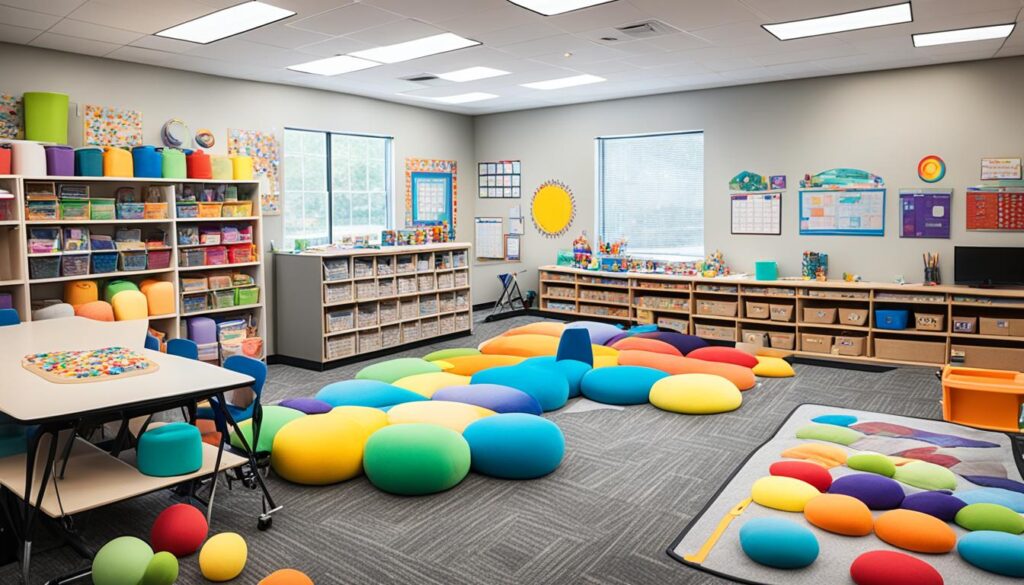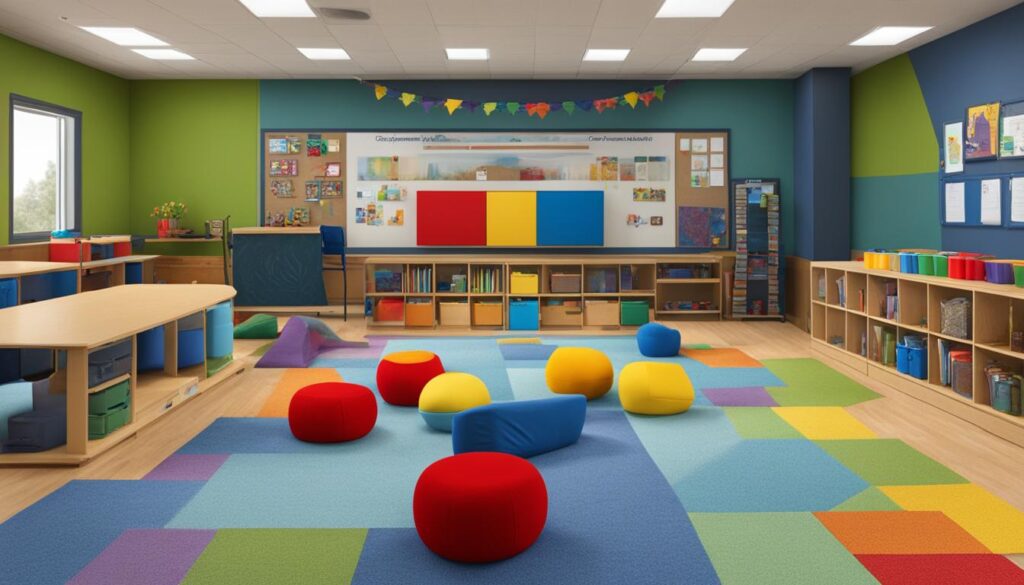How can you create a sensory smart classroom? Educators aim to support all students, including those with sensory processing challenges.”
Making your classroom sensory smart is key for an inclusive, peaceful learning space. Specific strategies and changes can reduce disturbances. This helps with sensory integration in schools.
Key Takeaways:
- Creating a sensory-friendly space is vital for students with sensory issues.
- Less visual clutter and noise make learning better for students.
- Using sensory tools and accommodations helps students with these needs.
- It’s important to help with sensory regulation through special strategies.
- Supports for sensory needs make switching between activities smoother for students.
Creating a Calming Classroom Environment
Making a classroom calming is key for a good learning experience. Reducing clutter and noise helps students focus and relax.
Here are ways to cut down on visual clutter:
- Keep walls and boards partly empty to reduce too much visual stuff.
- Use folders or dividers to help students focus on their work.
To make the classroom quieter, try these:
- Switch fluorescent lights for natural light or lamps to lessen flickering.
- Add sound-absorbing items like rugs and bean bags for a quieter room.
- Offer noise-reducing headphones for students who need a more silent environment.
By focusing on reducing clutter and noise, teachers can create a peaceful space. This helps students focus better and improves their well-being.
Sensory Tools for the Classroom
Using sensory tools in the classroom helps students who have trouble with sensory processing. These tools make classrooms better for kids with sensory needs. They help them manage how they experience their senses. This creates a learning space that includes everyone.
Here’s a list of good sensory tools for classrooms:
- Noise reduction headphones: These help kids focus by blocking out background noise. They’re great for kids who are easily bothered by sounds.
- Fidget tools: Items like tangles or string fidgets let kids feel things, which helps them stay concentrated. They can use them quietly without distracting others.
- Tactile play materials: Sensory bins or Play-Doh are great for touch and can make learning more hands-on. They let kids explore and learn through touch.
- Visual sensory tools: Tools like colored overlays or vision bottles assist kids who need visual help. Overlays make reading easier by reducing strain. Vision bottles offer something calming to look at.
By offering different sensory tools, teachers can meet the varied needs of their students. This helps make the classroom more welcoming and supportive for everyone.

Promoting Sensory Regulation in Schools
It’s really important for schools to help students with sensory issues. By using special strategies and activities, teachers can help these students feel better. This makes the school a better place for learning. Let’s look at some ways to do this.
1. Proprioceptive Input Strategies
Understanding how to control their body is key for students. Using proprioceptive input methods helps with this. Here are some things teachers can do:
- Use stress balls or weighted blankets to give deep pressure.
- Offer chairs with good back support for more stability.
- Suggest stretching or yoga to increase body awareness, like the child’s pose or downward dog.
2. Vestibular Input Activities
Activities that stimulate the inner ear are great for students needing extra sensory help. These help with balance and knowing where you are in space. Here’s what can be done:
- Have a special area with swings, balance boards, or mini trampolines.
- Let students do movement breaks, such as jumping jacks or hopping.
- Add activities with spinning or rocking, like spinning chairs or rocking on a ball.
Teachers should give students regular breaks. This way, they get enough chances to move in ways that help them.
Having a school that understands sensory needs is super important. By using proprioceptive and vestibular activities, learning becomes easier for everyone. This approach makes the school welcoming and helpful for all students.
Sensory Supports for Smooth Transitions
Smooth transitions are key for students in sensory smart classrooms. Teachers can help students by using sensory supports. They can use visual, olfactory, and tactile strategies to make transitions easier.
Visual Input Strategies
Visual input is crucial for easy transitions. Teachers should use natural light and avoid flickering lights. This makes a calming environment that helps students focus and reduces sensory overload. They should also limit visual distractions, like too many posters or clutter, to improve concentration during change.

Olfactory Input Strategies
Smell can also help with transitions. Using essential oils or scented markers in class can calm or energize students. Certain scents can signal different activities, helping students switch tasks smoothly.
Tactile Input Strategies
Tactile input is another way to help students. Sensory paths with different textures on the floor engage students as they move. Touch fidgets can also help. They allow students to manage their sensory needs quietly, keeping them focused and calm during changes.
By using visual, olfactory, and tactile strategies together, teachers can take a multi-sensory approach to transitions. This complete method helps students with sensory challenges navigate changes successfully. It keeps them focused on their learning journey.
Increasing Sensory Awareness in Students
It’s essential to weave sensory input into the school day. This helps students become more aware of their sensory needs. They learn how to manage these needs in a way that works for them.
Creating a “My own learning space” is a great approach. Here, students have their own area filled with tools that block out too much stimulus. This space helps them stay calm and focused.
Taking regular breaks for sensory activities is also key. Practices like the downward dog or head-below-knee pose are good examples. They give the right kind of sensory input to help students regulate themselves.
Teaching kids about sensory processing is vital. When they understand their sensory preferences, they’re better able to handle them. We give them tools and knowledge to help themselves.
By adding sensory inputs into their daily routine, we help students stay aware of their needs. This support helps them do better in school and in life.
| Sensory Activity | Description |
|---|---|
| My own learning space | A designated area with sensory-blocking tools for self-regulation. |
| Sensory breaks | Engaging in activities like yoga poses for sensory input and self-regulation. |
| Sensory education | Teaching students about sensory processing and their individual sensory needs. |
Sensory Strategies for Behavior Management
Using sensory strategies can really help handle behavior in class. This is especially true for students feeling overwhelmed by too much sensory input. By introducing special ways that increase body awareness and touch feedback, teachers can guide students in controlling their sensory experiences. This helps steer clear of unhelpful behaviors.
A cool method is to arrange a comfy seating spot from a cardboard box or laundry basket. Fill it with pillows. This makes a cozy and safe place for students to sit. It makes them more aware of their body’s position and sense of touch. Also, giving them things to chew like necklaces, or crunchy snacks can change unwanted behaviors into positive actions. This meets their sensory needs.
To really support positive actions and learning, it’s essential to create an understanding space. This space needs to recognize and meet students’ sensory requirements. With the right sensory strategies, teachers can help students deal with being overwhelmed. This allows them to take full part in class activities.

